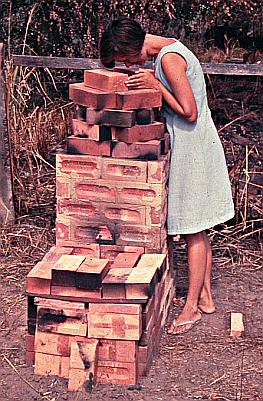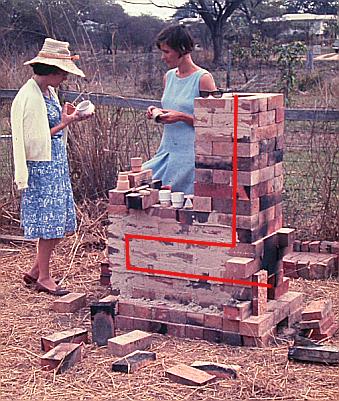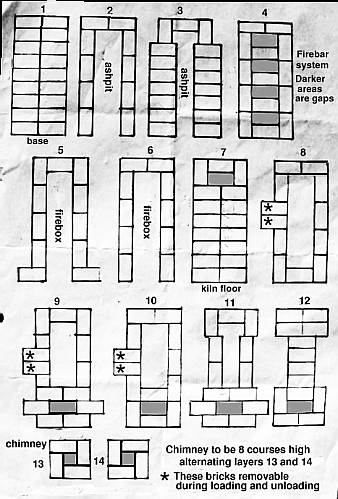![]()
First kilns: Carol and Arthur Rosser
This is our first kiln of any sort. We saw the plan in an Ivan Englund article in Pottery in Australia magazine, May 1965. We still remember the words '..there is a great deal of sheer fun to be had learning about pots in this basic and fundamental way.....'. This kiln had just one virtue and that was immediacy. There was no mucking about. 100 bricks, some sort of firebars, a sheet of iron to cover the top of the firebox, pinch pots made of any old clay with some sand in it, a glaze with the sophisticated recipe of 50 borax, 50 clay, an hour of building and you are ready. Remove the bricks at bottom left to expose the firebox, take the bricks off the top of the chimney where Carol is peeping in, put the pots at the base of the chimney/chamber, start the fire and throw in any old wood and you are on your way. The kiln fired to about 900 C in two hours but you had to slow down to three or four hours for the bisque. We were anxious to make life more complicated and quickly moved on.
At right: Carol Rosser peeping at pots 1966
This was rash, as that is exactly where residual heat
would be rising

Our second kiln was a lot more sophisticated.
The red line indicates the flame path.
We think of this one as firing to 1000 C, and Carol
remembers using cones so that is probably correct. The
dimensions of the kiln were dictated by the use of
standard 9ins x 4.5ins x 3ins house bricks, as you can
see from the kiln plan below. We fired this quite a
number of times with the borax and clay glaze mainly,
but there are any number of low temperature glazes
around.
We had been reading A Potter's Book by Bernard Leach and this was leading us towards functional stoneware, so we soon bought a gas kiln. We did not get back to woodfiring for about 12 years.
At right: Carol and a neighbour, Lenore, after a bisque firing.

The old kiln plan was in a folder, so here it is. From the photos above you can see that there was an attempt to seal the gaps with a clay/sand mixture. In fact the bricks crept apart during firings and had to be tapped back into place with a hammer.
Ivan Englund was right. There is a lot to be said for this sort of low temperature firing. The aesthetic possibilities are actually unlimited and this sort of kiln certainly helps to satisfy the basic human urge to make things.
If you have questions about these kilns just email arosser@sidestoke.com
Go here for more recent Rosser kilns (external link).
